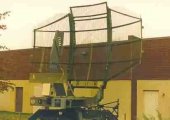AN/TPS-43
Description of the radar set, tactical-technical characteristics
in service since: 1966;
U.S. Air Force Standard since: 1968
| Specifications | |
|---|---|
| frequency: | 2 900 - 3 100 MHz |
| pulse repetition time (PRT): | 4 ms |
| pulse repetition frequency (PRF): | 250 Hz |
| pulsewidth (τ): | 6.5 µs |
| receive time: | |
| dead time: | |
| peak power: | 2.8 MW |
| verage power: | 6.7 kW |
| instrumented range: | 450 km |
| range resolution: | |
| accuracy: | |
| beamwidth: | 1.1° |
| hits per scan: | |
| antenna rotation: | 10 seconds (6 rpm.) |
| MTBCF: | |
| MTTR: | |
AN/TPS-43
AN/TPS-43 is a lightweight air and ground transportable radar designed for use with manned aircraft or surface-to-air missile batteries in a wide variety of tactical environments. It provides complete 3-D cover to 447 km on a fighter or fighter-bomber aircraft and measures heights over the full range by signal amplitude comparisons in six channels. Extensive clutter rejection and electronic counter-countermeasures features are incorporated in the design, including a digital coherent moving target indicator system, pulse-to-pulse frequency agility, Jamming Analysis and Transmission Selection (JATS), coded pulse anti-clutter system and sidelobe blanking. This latest model of the AN/TPS-43 includes extensive equipment refinements and increased operational capability.
For ease of air shipment the equipment divides simply into two pallet loads each of less than 3400 kg. One load comprises the shelter unit, including transmitter/receiver and displays; the other consists of the antenna assembly, the feed and ancillary equipment. The entire equipment can be packed into two M35 trucks for road transport.
To minimise weight, light alloys are used wherever possible in the main mechanical structures and micro-miniaturisation techniques are used in the electronics circuits. The transmitter uses a completely solid-state modular modulator to pulse a linear beam Twystron.
The feed array features the use of a stripline matrix to form the height-finding beams. The identification friend-or-foe antenna is a sum and difference type providing an Interrogator SideLobe Suppression (ISLS) capability. A small printed circuit reference antenna is mounted on the back of the radar feed to act as the radar sidelobe reference antenna. Use of this latter antenna during the dead time between transmitter pulses is available for the JATS function.

